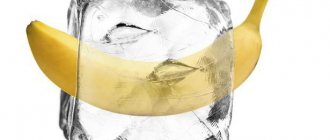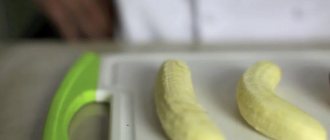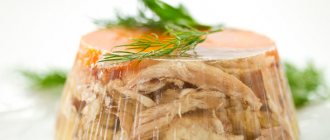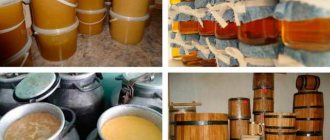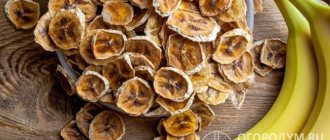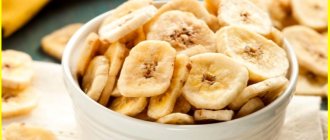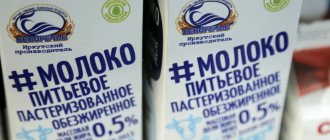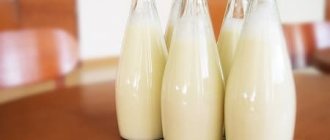Everyone loves bananas - both adults and children, and a lot has already been said about the benefits of bananas and banana peels.
Let's figure out which bananas are healthier - fresh, greenish ones, or those that have been in the kitchen for a long time, become very soft and even blackened?
We will also consider the rules for preserving and storing bananas.
Briefly about the benefits of bananas... Bananas contain easily digestible carbohydrates, as well as glucose, fructose and sucrose. In addition, bananas are rich in minerals and vitamins. Banana is a powerful antidepressant. It contains a large amount of vitamin B6. It is he who is responsible for the formation of the happiness hormone. Bananas also contain a lot of potassium, which is essential for heart function. Bananas are also essential for our blood. Yellow fruits contain a large amount of iron, which increases hemoglobin levels. Banana pulp is an excellent sorbent and cleanses the body after poisoning.
There is an opinion that bananas should be avoided during a diet, as they are rich in starch. But nutritionists do not agree with this - bananas contain malic acid, as well as enzymes, thanks to which carbohydrates are absorbed better. In addition, a banana can help the body maintain a certain level of blood sugar, so you are not at risk of attacks of uncontrolled appetite. Good news for those losing weight is that 100 g of bananas contain only 90 kcal, while bananas have no fat at all.
The right banana
As a rule, a certain variety of bananas goes on sale - Robusta moris. Also, mainly table banana varieties appear on the CIS trading floors: Gros Michel, Cavendish, Lakatan. But sometimes there is another variety (I, for example, came across it :), popularly called fodder banana. This green banana is a separate variety and not unripe bananas. The fruits are large and inedible raw. Banana chips are made from them here. You can also boil them, etc. It is sold not in fruit shops, but in vegetable shops, along with cabbage and potatoes.
Remember that the correct banana is characterized by a rich yellow color, a slightly ribbed, streamlined shape, and a shiny, smooth surface. The parameters of a high-quality banana fruit have long been determined: volume 3-4 centimeters, length 20 centimeters or more.
If the bananas are yellow, then the tail should ideally be slightly greenish, not dark. One or two bananas a day will be enough. Nutritionists do not recommend eating them on an empty stomach.
So, bananas contain a large amount of nutrients and essential vitamins that are vital for health. But a lot depends on their color.
Dried bananas
They are hearty and healthy desserts, tolerate transportation well, and are convenient to take with you on the road. They take up little space, do not require special conditions, are very nutritious, and provide a long-lasting feeling of fullness. The principle of preparing sun-dried and dried bananas is very similar, only in the first case they are cut into large pieces (small fruits are processed whole). In the second, thin plates-circles are formed.
Most varieties darken in the open air. To preserve color and taste, before processing, soak them for a minute in a mixture of cool water and the juice of 1 lemon. Then put it in a colander and let it drain.
You can dry and dry it in the sun, in the oven or in an electric dryer. Outdoors, this process will take 2–4 days. The tray must be removed indoors at night and monitored for insects. It goes faster in the oven; it will take 3 hours at a temperature of 70 degrees. The final result will depend on the degree of drying: you will get dried or dried fruits.
The electric dryer provides uniform heating and air circulation and is well suited for making chips.
The finished product is placed in a tightly sealed container in the refrigerator compartment. Well-dried banana chips can be stored in linen bags for about 1 year.
Video:
recipe for dried bananas in an electric dryer Expand
Green bananas
The texture and flesh of green fruits is firmer than that of ripe ones. Green bananas, also called baby bananas, fill you up faster, helping you lose weight by regulating your appetite. They have a low glycemic index and control blood sugar levels.
Benefits of unripe bananas:
- Because unripe bananas have more starch, this means they contain less sugar (which is why they don't taste sweet). This may be especially helpful for people trying to avoid sugar, such as people with diabetes.
- Eating green bananas helps prevent heart problems by lowering blood cholesterol levels.
- The starch in unripe bananas can make you feel full faster and longer. This makes them a great snack between any meals. It can also help you burn more fat faster,
helping you lose weight by regulating your appetite.
They have a low glycemic index and control blood sugar levels. - Higher probiotic saturation.
Probiotics are especially beneficial for the colon. They also help improve the absorption of nutrients (especially calcium). - Green bananas are rich in vitamin B6 . It is important for nearly 100 enzymatic reactions in the body and is necessary for the production of hemoglobin, which also saturates the body with oxygen.
Method No. 1. Freezing whole bananas
- Determine how you will freeze bananas - peeled or peeled. If the banana is “naked,” it will last about one month longer. But the peeling process is not always a pleasant experience, since overripe bananas can break. If bananas are frozen for further mashing, it is better not to peel the fruits. And if the whole fruit is added to the dish, then the right decision will be to remove the skin. There is no need to be afraid of the skin blackened by freezing; the fruit itself will not deteriorate from low temperatures.
- Peeled bananas should be placed on a special tray in the refrigerator or cutting board. Pre-cover the surface with sheets of parchment paper. Place the fruits at a distance from each other so that they do not touch each other. Place the tray in the freezer to allow the fruit to freeze completely.
- Place frozen bananas in plastic bags. It is better if they are specially designed for storage in the freezer. Label each bag with the date the fruit was frozen.
- When you need the bananas, remove as much as necessary from the refrigerator so as not to refreeze the bananas.
Yellow bananas
Ripe and yellow bananas are rich in antioxidants that fight diseases caused by free radicals in our body. They contain an ingredient called dopamine, which prevents heart disease, reduces the risk of degenerative diseases and improves mood.
Benefits of ripe bananas:
- When bananas are soft and very ripe, they are much sweeter. This happens because complex carbohydrates and sugars gradually break down into simpler sucrose over time. This means that it is much easier for the body to absorb them; this product is very useful for digestion .
- Ripe bananas contain more antioxidants. Antioxidants are good for health : they improve immunity, have anti-aging and anti-inflammatory properties.
- Yellow bananas contain magnesium, which can help you cope with insomnia, as these fruits have neuroprotective effects and relax the muscles of the body. Magnesium also lowers brain temperature and regulates hormones.
- Yellow bananas are also one of the richest sources of potassium , which is a metabolism-regulating electrolyte; It helps the body produce energy and promotes protein synthesis, which is important for the production of muscle tissue.
- Bananas also contain phosphorus , which is essential for bone health and is one of the components used to make DNA in the body.
Method number 3. Freezing banana puree
- Peel the fruits, cut into pieces and mash well with a fork or using a blender.
- Pour lemon juice into the container with the puree at the rate of one tablespoon per 250 mg of puree. Mashed bananas store better due to the acid contained in citrus fruits. But if there are no lemons in the house, then ascorbic acid can become an analogue. Mix ascorbic acid in the amount of ¼ teaspoon in 15 mg of water. Pour the solution into the puree.
- The puree should only be frozen and stored in a sealed container. These can be plastic containers with lockable lids. In this form, bananas can stay in the freezer for no more than four months, so you need to stick pieces of paper with dates on the boxes.
If you follow the above recommendations, you can extend the life of tropical fruits and enjoy their taste and aroma for a long time.
Yellow bananas with brown spots
Ripe bananas contain much more useful vitamins and various microelements - this is also a fact proven by scientists. But here’s the most amazing thing: bananas, which are already beginning to turn black, are a source of an incredibly effective substance that can even fight cancer cells!
When a banana is already very ripe, a powerful antioxidant begins to be produced inside it, which inhibits the growth of tumor cells and prevents their spread.
Brown spots on bananas indicate the presence of TNF (tumor necrosis factor). TNF helps fight abnormal cells in the body.
Optimal storage conditions
Due to the difficulties of transportation, bananas are often brought to the store green and unripe.
In order for the fruit to remain fresh and not lose its taste and beneficial properties, it is necessary to maintain certain conditions:
- Optimal temperature. The main reason for loss of presentation of a product is unacceptable temperature conditions. Long storage time is ensured by temperatures from +12 to +14 degrees. Standard +22...+25 degrees in the room are destructive for fruit. And under the influence of cold in the refrigerator, they will quickly become covered with black spots.
- Required level of air humidity. As the liquid evaporates from the banana skin, the flesh dries out and loses its shape. To prevent excessive evaporation of air and conserve moisture, the legs of the fruit are wrapped in cling film and foil.
- Lack of direct sunlight. When exposed to the sun, fruits quickly turn black and spoil.
How to store ripe bananas at home so they don't turn black?
To slow down the process of darkening of the fruit, you need to separate all the fruits from the bunch and wrap the stem in food foil. This way the stalk will not dry out and the fruit will retain its presentation for a long time.
Read more ► How to store figs: 3 options and 5 recipes for storing and preparing
Where is the best place to store it?
When overcooled, the product turns black; when the temperature exceeds +22 degrees, the same thing happens.
The ideal storage location is a cool pantry or the bottom shelf of a kitchen cabinet.
It is not recommended to leave bananas in the refrigerator for a long time. The exceptions are the following cases:
- If the fruits are already cut into circles, they are covered with a plate on top and eaten within the next 2-3 hours after being left in the refrigerator.
- If it's a hot summer, there is no cool corner in the apartment, there is no air conditioning.
The maximum storage time for ripe fruits in the refrigerator is one day. They are placed on the refrigerator door, previously wrapped in soft paper.
The maximum storage time for ripe fruits in the refrigerator is one day.
At what temperature?
Storage conditions for ripe fruits:
| Temperature (in degrees) | Storage time in days |
| It is not recommended to store: the fruit loses its presentation, darkens, deteriorates | |
| +1 to +10 | Maximum 2-3 days |
| +11 to +12 | About 3 days |
| From +13 to +15 | From 14 to 20 days |
| +15 to +20 | About 3 days |
| Above +20 | Will have to eat within 5-6 hours |
Can I freeze it for the winter and how to do it?
When there are a lot of ripe bananas, it is impossible to eat them in the near future; the only way out is freezing.
Ripe, overripe fruits are suitable for freezing; green fruits are not used.
Method for freezing bananas at home in the freezer:
- The peeled fruits are first washed with running water to wash away ethylene and microbes. Excess moisture is blotted with a paper napkin.
- It is better to use a separate freezer container so that there is no other food in it.
- The fruits are separated from the bunch, each packaged in individual bags. The shelf life of frozen fruit is 8 weeks.
- Bananas removed from the freezer will turn brown, but this is just the skin. Under it, the fruit will retain its benefits and taste.
Where to keep green bananas to ripen?
Unripe fruit tastes like grass. Therefore, housewives prefer to leave them to keep up. To speed up ripening, a bunch of fruit is hung on a hook in a place protected from daylight.
Read more ► How to choose and store dried fruits, wash, freeze, fight mold and insects
The temperature should not exceed +17 degrees; it is preferable to place the fruits in the pantry.
Important! To increase the storage time of green fruits, you need to wrap the stalks in food foil. They should not be placed next to ripe bananas: the release of ethylene from them will significantly speed up the ripening process.
Benefits of blackened bananas
Brown bananas are the sweetest and contain a lot of potassium. Such products help prevent diseases such as osteoporosis. They also contain tryptophan, which has been shown to improve mood, reduce anxiety, and promote better sleep.
Japanese researchers have found that the more a banana ripens, the more fiber, vitamin C, B vitamins, potassium and antioxidants it contains.
The older the fruit, the faster it is digested in the body, so brown bananas are best for people with digestive problems.
Eating ripe and overripe bananas is very beneficial for the immune system; this will help your body quickly cope with any infection and not catch a new one. Remember this the next time you are about to throw away an overripe banana :). Although, of course, eating a blackened banana is unpleasant not only from an aesthetic point of view - its taste also changes, and not for the better. Not to mention the consistency, which completely turns into some kind of brown mucus.
In warm weather, especially in summer, it is better to forget about BUYING “spotted” and “blackened” bananas, despite the fact that they are sold at a reduced price. Like any spoiled product, an overripe cracked banana strongly attracts fruit flies. It doesn’t matter where bananas are sold, on open trays or in stores. The sellers drive away the flies and continue selling bananas. This is the main danger. Flies penetrate under the banana peel through cracks, as well as through those very “specks” where the skin becomes very thin. While feeding on a banana, the fly lays eggs at the same time. Of course, this is not immediately noticeable; people calmly buy cheap fruit and eat it. But if you leave such bananas in a tied bag, after three days you can get a real shock when you see the number of larvae on them.
Regardless of the stage of ripeness, bananas contain a ton of nutrients per fruit. They are a great snack that keeps your blood sugar levels up and can keep your energy levels up throughout the day.
Features of storing sliced bananas
Sliced fruits quickly darken and disappear. To avoid this, choose the right way to store your banana slices .
Method No. 1: processing with fruit juice
Fruit juice for this purpose is suitable either purchased or prepared with your own hands.
These juices are preferable:
- citric;
- grapefruit;
- orange;
- canned pineapple;
- apple;
- lime juice.
To preserve fresh fruit slices, sprinkle them with juice from a spray bottle . If you don’t have one, a brush used to grease baked goods will do.
Also, banana pieces will be processed well if you put them in a plastic bag with juice and carefully turn them over 2-3 times. But this method will change the taste of bananas more than using a brush or spray.
A juice bath will help refresh slightly darkened slices . Pineapple and grapefruit will do the best job of lightening. The slices are immersed in a container with juice for 10-15 minutes so that they are completely covered with it. The color will lighten to yellow, and the fruit itself will acquire a pleasant taste.
Method number 2: treatment with soda
Carbonated water will help keep bananas looking fresh due to the acids in its composition . Before putting the slices in the refrigerator, dip them in gas water for 10-15 seconds.
Use unsweetened soda, no added syrups . Flavoring additives will give the slices an unpleasant aftertaste.
Method No. 3: treatment with powdered citric acid
Citric acid packets used in baking will also help keep the fruit fresh and prevent it from turning black.
Treatment with citric acid goes like this::
- Pour 3 tbsp. l. powder (15 mg) per cup.
- Pour 250 ml of water at room temperature.
- Stir until smooth.
- Dip banana slices for 10-15 seconds.
- Place in an airtight container and place in the refrigerator.
Method No. 4: treatment with plain water
Water is less effective than juice, but will also extend the freshness of sliced bananas by 5-7 hours . The treatment is carried out in the same way as with citric acid. The slices are immersed in water for 10-15 seconds.
If you plan to give such fruits to children, it is better to use boiled water . Bottled or filtered will do. Bananas absorb large amounts of water, and if it contains bacteria (for example, E. coli), they will receive a favorable environment for rapid reproduction. Babies and people with a sensitive gastrointestinal tract will experience stool upset.
How to speed up the ripening of bananas
In order for bananas to reach the consumer fresh from southern countries, they are picked and packaged long before the ripening period - while still green. Often, after buying bananas, the consumer brings them home unripe. This problem can be easily fixed using the following methods:
- Pack the fruit in a paper bag and store for some time. Bananas have the ability to produce a gas that speeds up their ripening - ethylene. A paper bag prevents it from scattering throughout the room and speeds up the ripening of fruits. A polyethylene bag will not allow air to penetrate to the fruit, which is why ethylene will be produced more slowly. The following subtleties are important here: - put other fruits in the bag with bananas (ideally: pears, apples, quince or kiwi), which also emit such gas. - one of the ripest fruits can even be cut into pieces, which will speed up the ripening of other fruits.
- You can speed up the long ripening period of bananas if you store them indoors at a comfortable temperature (from 18 to 20 degrees). If the apartment is warmer, the fruits may ripen faster, but not too evenly. But storing the latter in conditions of high humidity can contribute to the formation of mold, which can cause them to deteriorate.
- Low humidity levels also do not improve the taste of bananas. Even fresh fruits, if stored at home this way, can lose their fresh and sweet taste. In this case, a running humidifier or small containers of water placed around the room will help.
- Green bananas that are stored correctly can ripen in 2 days. Therefore, it is important to look at them in a timely manner to prevent them from being damaged.
- You can help the fruits ripen in the oven: preheat the oven to 80 degrees (to prevent the fruits from turning black, do not exceed this mark); — place the bananas on a baking sheet previously covered with baking paper (no need to peel them); — literally after 30 minutes the bananas may darken, you don’t need to hold them for a long time so as not to spoil them; - Now put the fruit in the refrigerator or use it for its intended purpose.
- Another life hack involves freezing the fruits; it is worth remembering that this method causes them to turn black. In this case, use them to make smoothies.
How to choose bananas
When approaching a display case with gifts from the tropics, keep in mind that the choice of a product of one category or another is determined by whether you plan to keep them at home for some time before eating them. In any case, limit yourself to a small amount of fruit. It is not worth purchasing several bunches at once, since bananas are a perishable product, and not every homeowner has the opportunity to store them in conditions comparable to a warehouse.
For storage up to several days
Overripe fruits are not suitable for storage for up to several days - they should be peeled and eaten immediately (some people like these bananas more because they are especially sweet). Yellow exotic fruits are best suited for short-term storage.
Please make sure that there are no even small spots on the peel, much less traces of mold. The latter means that the fruit was stored incorrectly and managed to absorb toxic substances. A broken peel is also a bad sign - underneath you will most likely find dark pulp. In addition, fruit flies can enter through the damage and lay eggs. This is especially true for bananas purchased from street vendors.
For storage from several days to several weeks
If you are planning to stock up on several bunches of bananas for future use, pay attention to green fruits - they can be kept at home for up to two weeks. Fruits of other ripeness categories cannot be preserved for so long without resorting to freezing or drying.
6 reasons not to throw away banana peels right away
How to properly store bananas at home
To keep fruits unchanged for longer, it is worth remembering some tricks that depend on the appearance of bananas:
- Green, with a dense, ribbed skin: these fruits are not ripe and will best be stored in a dark place at room temperature.
- Eat a ripe banana with a greenish tail and smooth peel immediately. It will keep for a day on a fruit plate on the table.
- Bananas have a dark peel, with brownish spots, and are soft in structure: they should not be stored in principle; they should be used immediately for cooking.
General principles for proper storage of bananas:
- It is best to divide the bunch into separate specimens, which will allow them to ripen evenly and not deteriorate from close contact.
- Wrap the lower part of the fruit, near the legs, with cling film, securing it securely with tape.
- To prevent accelerated ripening of fruits, it is better to store them outside of packaging or bags.
- Keep the fruits in the refrigerator; here they will ripen a little slower. To keep bananas longer and avoid dark spots, wrap each banana in cling film. Now, even after a few days, the fruit will remain fresh and beautiful. However, they can still begin to darken, which will not affect the taste in any way, but can only spoil the aesthetic appearance.
- It is best to keep bananas away from other fruits, otherwise they will not last long, helping each other in ripening due to the ethylene released.
Separately, it is worth considering the issue of storing bananas that have already been peeled. There are several ways:
- Freeze the fruits by first cutting them into discs and placing them in a plastic container. This way, bananas can last up to six months, after which you can use them as a filling for pies or chop them into cocktails.
- You can extend the life of chopped fruits by a day by soaking them in an aqueous solution of vinegar (1 to 4).
- Place the fruits in a container and hide them in a cool place.
- To protect fruits cut for the holiday table from darkening, sprinkle or grease them with lemon or orange juice.
Can I freeze it for the winter and how to do it?
Since banana fruits are not recommended to be stored in the refrigerator, the question arises whether bananas can be frozen in the freezer. Can!
Freezing is an excellent option for processing overripe fruits. This product is usually used to make chilled cocktails and dessert dishes.
The question of whether it is possible to freeze bananas for the winter may seem strange to some. But if in some region bananas are not sold all year round, then there is simply no other option!
How to do it:
- Cut the peeled bananas into slices, put them in ziplock bags, and put them in the freezer.
- Remove the peel, place the whole fruit in a plastic food container, sprinkle with lemon juice, cover with a lid and place in the freezer.
- Use a blender to make banana puree, add lemon juice, pour into silicone molds, and freeze.
The positive answer to the question whether bananas can be frozen is obvious. Proper freezing extends the shelf life to two months. In addition to all of the above, bananas can also be dried.
How long can bananas be stored?
In order not to worry about the fact that recently purchased fruits quickly deteriorate, foresee in advance why and how soon they will be needed, and based on this, purchase fruits.
- If bananas are bought for future use, with a supply of a week or more, it is better to prefer green fruits, with a hard peel, but without visible scratches, stains and damage that are not yet ripe. They do not need to be frozen, just put them in a dark place where they will keep well, gradually ripening.
- If bananas are purchased for immediate consumption , preference should be given to ripe fruits (they have a rich yellowish-straw hue, a dense peel and no visible defects on the skin). Such fruits can be stored for 1–2 days at room temperature.
- If you need the fruits for making cocktails or smoothies, buy slightly darkened bananas with brownish streaks on the peel . They have juicy pulp, which is in a mushy state. You cannot store them, because they will quickly deteriorate; it is better to clean them immediately after purchasing and put them into use.
- Fruits whose skin has a shade of gray should not be purchased at all. This color indicates that they lay in a room where it was either hot or cold or were repeatedly placed in the refrigerator; most likely, their taste will be hopelessly spoiled.
It is very important not to store bananas at home in the plastic bag in which they were packaged in the store. Fruits can rot very quickly in it. Place fully ripened bananas for storage in the refrigerator, where they (while darkening a little) can easily remain for up to 2 weeks without losing their taste.
Standard shelf life of bananas
The shelf life of bananas is directly dependent on the stage of fruit ripeness and storage conditions. Here's how long bananas can be stored considering the above factors:
- Professionally equipped chambers can provide a storage period of up to 50 days.
- If stored at normal room temperature, without taking special preservation measures, the ripe fruit will begin to deteriorate on the second day. A competent approach to the issue of storage can significantly - up to one week - increase the shelf life.
- Green fruits can be preserved at home longer than yellow ones - up to two weeks.
- The fruit can be preserved for the longest time in the freezer - two to three months.
The right approach to how to store bananas at home can significantly increase the life of this exotic fruit!
This is how bananas are stored during transportation.
Can bananas be stored in the refrigerator?
Some people are of the opinion that the best way to keep fruits fresh and beautiful is in the refrigerator. However, as far as bananas are concerned, it is optimal for them to be stored at a temperature of about +14 degrees, and sudden changes should not be allowed.
The ideal place for these fruits would be a basement, where it is possible to maintain the humidity level within 90%, provided that ventilation is possible. Wrap the fruits in foil, this will keep them unchanged for a week.
In general, storing bananas in the refrigerator is not the best option due to the following reasons:
- the peel may darken;
- the pulp becomes soft and mushy;
- cold speeds up the ripening of bananas, which can cause them to begin to rot prematurely;
- sharply changing heat to cold or vice versa (for example, if a bunch of bananas are taken out of the refrigerator, one is broken off and put away again) can spoil the taste of bananas and deprive them of some vitamins.
Ripe bananas stored in the refrigerator will not turn black on the inside. Only the peel will lose its aesthetic appearance, while the pulp will remain intact.
Why do they get dark at home?
Storing bananas at home is quite a difficult task.
During transportation, and later in warehouses, optimal conditions are created for the exotic fruit:
- the fruits are wrapped in a special film, which helps to achieve maximum shelf life - from 28 to 50 days;
- inside the storage chambers a stable temperature of the pulp is maintained within the range from +12 to +14 degrees;
- forced systems ensure continuous air circulation.
The blackening of the peel is due to the banana losing moisture. Unlike other tropical fruits - such as orange, mango, avocado, pineapple - the banana fruit is not protected from the external environment by a hard shell, which slows down the drying of the fruit. In view of this, the question of how to store bananas at home presents some difficulties.
Brown dots and specks are not a sign of deterioration. They indicate the highest degree of maturity. The lack of aesthetic pleasure from consuming such a product is another matter. Blackened fruits are unfit for consumption!
Step by step damage process:
- darkening of the skin;
- darkening of the pulp;
- loss of taste;
- unfit for use.
How to prevent bananas from turning black
These fruits darken most quickly if they are exposed to cold: this can happen if the fruits were purchased on a frosty day and the owner carried them down the street for a long time or because they were stored in the refrigerator.
Bananas can turn dark because:
- They were stored in a polyethylene bag. It's best to unwrap them and leave them unwrapped.
- They began to deteriorate even on the store counter (this is noticeable by the tiny dark spots that cover the peel of these fruits).
- Bananas were stored next to apples, which actively release ethylene.
By being careful not to make these mistakes, you will prevent bananas from unsightly darkening of the skin. Although this feature, most often (if the fruit is not spoiled), does not affect their taste in any way.
Description and properties of bananas
The mass supply of the product to Russian stores began at the end of the 20th century. With the opening of large European-style supermarkets, a large number of exotic fruits appeared on the shelves, including pineapples, kiwis, pomelo and bananas.
Many did not even suspect that they also come in different varieties and sizes, are exported from several parts of the world and have interesting effects on the body. The most surprising thing is that the composition of bananas is almost identical to milk. For children who have complex lactose intolerance, bananas and nutrition based on them become one of the chances of survival.
Banana is the collective name for the fruits of several members of the banana family. They are similar in shape, but differ in color, size, and taste. Minor differences are observed in the plants themselves. According to the botanical classification, they belong to berries, but during their cultivation, the seeds from the fruits disappeared, since reproduction occurs by vegetative means.
It sounds strange, but the plant is herbaceous. This is not a palm tree, but leaf petioles fused together, stretching to a height of 6–8.5 meters. The strangeness does not end there, since the flowers of the plant come in female, male and middle genders. Ovaries form on female flowers, while male flowers fall off after pollination. Why we need the middle ones, located in a separate tier, scientists are still arguing. A bunch weighs on average about 60 kg, the number of fruits reaches 300 pieces.
Interesting:
The plant's homeland is considered to be Oceania and the Malaysian Islands.
The first attempts at cultivation date back to the 5th millennium BC. Banana is mentioned in the sacred Buddhist texts, Ramayana and Mahabharata. Culture is considered exportable, important for the economies of exporting countries, and is supplied to most countries of the world.
How to Preserve Green Bananas
To preserve green-skinned bananas without allowing them to ripen, follow these rules:
- you should not leave them in sunlight, for example, on a windowsill, especially in summer;
- It is best to place the fruit in a dark, dry place where it will not be too cold or hot;
- the ideal place for storage would be a pantry; Pack the fruits in a paper bag, ideally hang the bunches vertically (the way they hang on a palm tree while ripening);
- Do not separate the fruits from each other, as this will cause them to spoil faster.
Banana ripeness categories
Bananas have three main categories of ripeness, which depend not on how long ago the fruit was picked, but on the storage conditions of the fruit:
- Green - have a green skin color and will gradually ripen during storage.
- Yellow (ripe) - bright yellow in color, with a smooth skin and a pleasant aroma, completely ready for consumption.
- Overripe fruits are still edible and have dark spots of varying sizes on the skin and brown flesh in places.
How to properly peel a banana according to etiquette
Banana is a fruit that (if it is not pre-cut into pieces) is quite problematic to eat nicely and neatly.
The rules of etiquette suggest the following:
- Before serving, wash the bananas thoroughly, dry them, cut off the top and tail, and also make small cuts along the peel on either side;
- they are served on the table on a fruit plate, lying separately from each other;
- a banana is taken from a common plate and placed on its own, intended for dessert;
- Using a special knife and fork for fruit, peel the banana;
- then the fruit is carefully cut into small pieces and put into the mouth using a fork;
- in this case, the peel remains on the dessert plate;
- These fruits are not peeled or cut in advance (before serving).
Do you want to surprise your guests? Here's an interesting life hack for you to use.
Take a needle, the length of which is at least the diameter of a banana. Clean the needle before use.
Find one of the banana seams and place the needle at the starting point. This point can be at the top or bottom of the banana.
Gently push the needle through the peel and into the banana. Push it far enough to get to the other side, but don't puncture the peel there.
Without tearing the entry point of the large hole, move the needle from side to side, creating a cut in the flesh inside the banana.
Once you feel the cut has been made, carefully pull the needle out and move it up (or down) about 1.5 centimeters along the seam and reinsert the needle. Make the next cut. Etc. Continue this process until you are finished.
In theory, it should look like this beauty. I myself, however, have not tried this method of cutting bananas...
based on materials from hoznauka.ru, vripmaster.com, takprosto.cc
Everyone has their own taste - some like greener fruits, others like sweeter and riper ones. For those who can't stand bananas that are too soft, don't worry. After all, you can prepare many different dishes from them - pancakes with banana, fruit salad, jelly...
To be healthy, it’s enough just not to reject the beneficial substances that nature itself gives you. Eat right and enjoy every moment of your life!
See also:
About fruits and diet
Bananas and their medicinal properties
Why do bananas turn black?
The formation of brown spots on the skin is a normal phenomenon, indicating the maturity of the fruit. Perhaps the darkened fruit looks unappetizing, but it is during this period that the pulp is the sweetest and the concentration of nutrients is maximum.
Sometimes tropical fruit turns black too quickly. This is directly related to violation of storage conditions. The dark color appears as a result of the fruit losing moisture, because the banana peel is too soft and cannot provide the fruit with sufficient protection from drying out.
Features of storing yellow fruits in peels
Keep bananas in their peels in a suspended state; it is better to select whole bunches in advance. The bunches should not be placed near other fruits; they will begin to deteriorate under the influence of the ethylene they release.
Where to store ripe bananas?
TOP 4 places at home where ripe bananas are best preserved:
- Cellar.
- A kitchen cabinet with no other fruit in it.
- Closed box on the balcony (suitable for the cold season).
- Food container in the pantry.
conclusions
Banana is a perishable product that requires special handling. To preserve the product, it is important to observe temperature conditions and storage rules, including, in particular:
- For long-term storage, it is better to purchase green fruits, and yellow ones for consumption;
- Storage in a dark place protected from sunlight prolongs the shelf life of the product;
- Hanging in clusters also increases shelf life.
Compliance with these rules will allow you to keep the banana in a respectable form for as long as possible and will allow you to enjoy its taste without any health problems.
